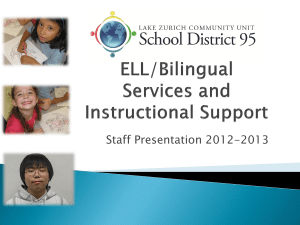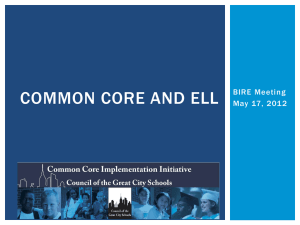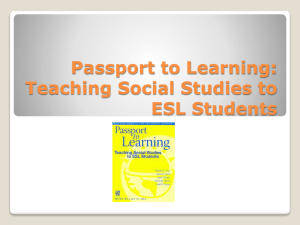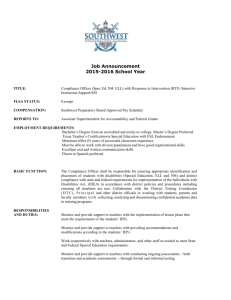ELL Legal Requirements Workshop.4.26.12
advertisement
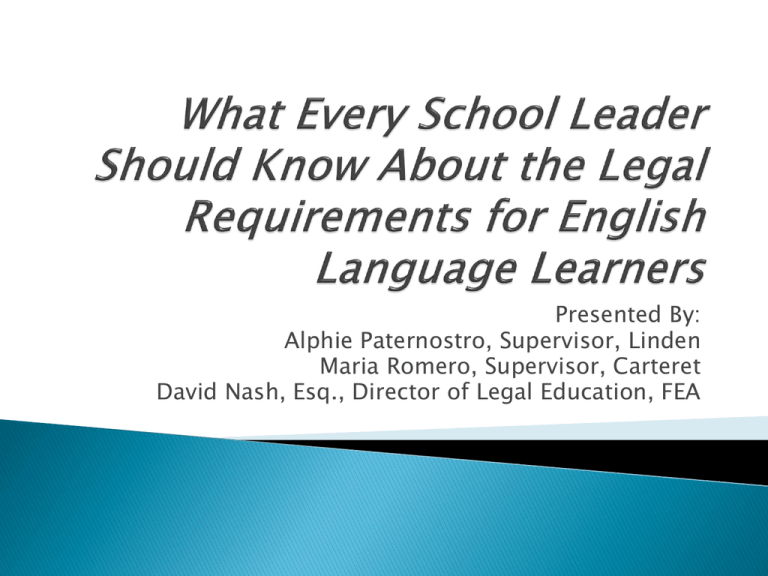
Presented By: Alphie Paternostro, Supervisor, Linden Maria Romero, Supervisor, Carteret David Nash, Esq., Director of Legal Education, FEA Identification and Registration of ELL Students Parental Rights Program Requirements, Triggers and Waivers Accountability Addressing Students with Multiple Needs Student Exiting, Reentry, Movement in and Out of District U.S. and New Jersey Constitutions Title III State and Federal Anti-Discrimination Laws ◦ (e.g., NJ Law Against Discrimination, Title VI) New Jersey Statute and Code ◦ N.J.S.A. 18A:35-15 to 26 ◦ N.J.A.C. 6A:15 State and Federal Case Law Lau v. Nichols – involved Title VI, Chinese students in San Francisco schools Plyler v. Doe – Involved questions on citizenship B.A. and J.H. v. Board of Ed. of Somerville (2009) OCR settlement – Los Angeles School Dist. ◦ New Jersey case on student who graduated in another country, right to education in NJ ◦ Involved disparate impact, lesser percentage of ELL and African American students in advanced classes, lesser access to best teachers First proactive civil rights enforcement action taken by Obama Administration Addressed disparities in educational opportunities for English Language Learners and African-American students Critical of underenrollment of ELL students in challenging courses, lack of access to effective teachers Requires district to develop, implement, monitor plan to strengthen delivery of instruction and increase participation in challenging courses Sends powerful signal that USDOE is not sitting back, waiting for complaints Indicates OCR not focused solely on purposeful, overt discrimination Forces ALL school districts to ask difficult questions about current participation of ELL students in all aspects of district’s educational program Should focus districts on developing plans to improve high end outcomes, NOT just focus on meeting minimum state standards What is your district’s current level of participation of ELL students in challenging courses (AP, honors, G & T, college prep)? What about current involvement in extracurricular activities, clubs, etc.? What steps can you take to improve these levels? Screening Process - Home Language Survey ◦ Must include date of initial entry to U.S. Use of multiple criteria for determining initial eligibility for services Identification of Eligible Preschool Students for accountability purposes (linked to student count for Title III funds) N.J.A.C. 6A:15 – 1.3 Cannot request information on citizenship Plyler v. Doe Cannot request social security number, income tax returns Cannot demand any single form of proof of residency, must consider any evidence provided Addressing Students from Other States Addressing Students from Other Countries See N.J.A.C. 6A:22 Often times process is largely unregulated in local districts May depend on the whims of the secretary in main office May indicate inadvertent support for discriminatory practices if left unchecked Cannot decide student is ineligible simply because student has a diploma from another case. Need case by case analysis – See Somerville case However, we must honor high school diploma for student from another state in U.S. Must establish bilingual education program when enrollment of LEP student reaches 20 or more in district ESL program – 10 or more ELL students in district English Language Services – Between 1 and 9 ELL students enrolled in district See N.J.A.C. 6A:15-1.5 May request waiver from requirement for bilingual education program. Must demonstrate would be impractical due to: ◦ Age range ◦ Grade span ◦ Geographic location Districts have legal obligation to address special education needs of ELL students Critical to determine if academic difficulties are related to language proficiency, lack of literacy in native language and/or learning disability Right to refuse student participation in bilingual program Right to remove student from bilingual program ◦ Need county approval to remove midyear Right to parental involvement in development and review of program ◦ Mandatory parent advisory committee Right to notifications in native language Initial identification as eligible for enrollment ◦ Must include notice of right to decline ◦ Must be in writing in native language and in English Notices provided to all other parents regarding their child’s academic progress and rights regarding student safety and discipline Notice that student should exit program based on appropriate exit criteria Purpose is to help ensure that LEP students attain English proficiency, develop high levels of academic achievement and meet same academic standards as all students are expected to meet Establishes standards (WIDA), assessments (ACCESS) and accountability requirements (AMAO) Provides federal funds targeted to ◦ Increasing English language proficiency ◦ Providing professional development Student enrolls in PreK in district Primary language spoken in home is not English For purposes of accountability under Title III (Annual Measurable Achievement Objectives) does the student’s time in preK count? Answer – It Depends If district is receiving Title III funds for student, then time counts for AMAO See N.J.A.C. 6A:15-1.3(c) Criteria for Exiting ◦ Results of English language proficiency test ◦ Assessing the level of reading in English ◦ Reviewing previous academic performance of students ◦ Standardized test results in English ◦ Input of teaching staff members Teen Dating Violence Act New Jersey Anti-Bullying Bill of Rights ◦ Protected characteristics include national origin, ancestry ◦ Catch all other distinguishing characteristics would include English language proficiency




